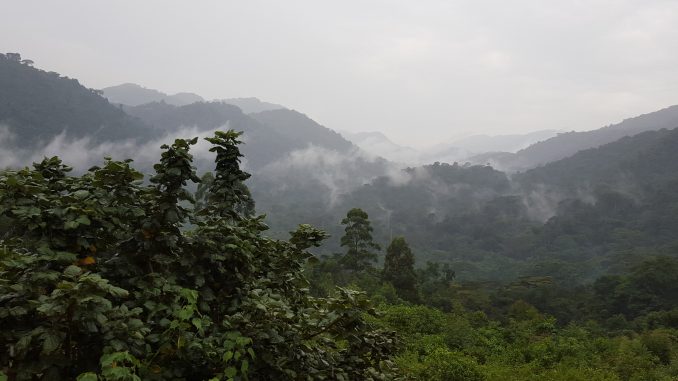
Rohan Roberts | 1st March 2016
Below are a few random notes, redacted from emails I sent during my stay in Uganda.
*** *** ***
Hello from the Bwindi Impenetrable Rainforest. This area has the highest concentration of Gorillas in the wild anywhere in the world. My lodge is right at the edge of the forest and the view from where I’m typing now is just breathtaking. Lush green vegetation, thick foliage, mist-covered green mountains merging into grey and rolling into the distance, the sound of myriad insects and exotic birds… Not a road or building in sight. Unbelievably pristine! Tomorrow morning I head out into that black wilderness with my guide in search of gorillas.
Uganda so far has been a wonderful experience. The people are respectful; Entebbe the city is relatively crime-free; and the food is not bad at all. Unfortunately, I chose the wrong dates to arrive. They’re smack-bang in the middle of their elections – which is the only time they have trouble on the streets in the form of demonstrations and riots. So all social media has been blocked. Uganda, like so many of its unfortunate neighbours, is ruled by a dictator, Yoweri Museveni – who every now and again goes through the charade of holding elections – and much like in places such as Zimbabwe, Libya, Iran and so on… the outcome is decided in advance. This time too, there is no doubt Museveni will win – like he has for the last 30 years!
*** *** ***
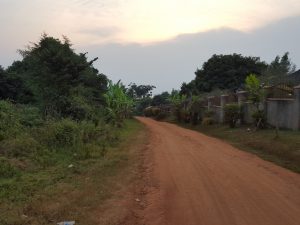 Entebbe is mostly known in the Arab world for the hostage siege in 1976. It’s a most extraordinary incident – one that made Israel seem invincible. Long story, but the brief version is this: An Air France flight from Tel Aviv to Paris was hijacked by Palestinian terrorists and flown to Entebbe, where the then dictator Idi Amin gave them support and permission to land. In what is considered one of the most outrageous and daring rescue missions ever, the Israelis put together a covert operation consisting of their most elite commandoes. They flew to Entebbe under cover, landed in the airport, shot dead all the Palestinian terrorists, killed the Ugandan security forces, saved all the hostages, and flew them back to Tel Aviv.
Entebbe is mostly known in the Arab world for the hostage siege in 1976. It’s a most extraordinary incident – one that made Israel seem invincible. Long story, but the brief version is this: An Air France flight from Tel Aviv to Paris was hijacked by Palestinian terrorists and flown to Entebbe, where the then dictator Idi Amin gave them support and permission to land. In what is considered one of the most outrageous and daring rescue missions ever, the Israelis put together a covert operation consisting of their most elite commandoes. They flew to Entebbe under cover, landed in the airport, shot dead all the Palestinian terrorists, killed the Ugandan security forces, saved all the hostages, and flew them back to Tel Aviv.
*** *** ***
There was a funny incident at the airport. I was at customs on arrival. This official with his dark 1980s Ray Ban shades, colourful epaulettes, and miscellaneous medals, stopped me and asked to see my bag. He rummaged through and found something that he thought was suspicious. He looked at me through his 1980s Ray Bans and said sternly, “What is dis?”
“Those are my binoculars,” I replied.
“Ah!” he exclaimed. “Bynocules!”
“Yes,” I said. “Bynocules.”
He called another custom official over, who looked at me and asked the same question, “What is dis?”
“It’s my binoculars.”
“AH! Bynoculays!” he cried.
“Yes.” I said. “Bynoculays.”
“Varrry nice. Varrry Good,” they both said, as they marveled at the binoculars. “Hey Edward, jast look at dis!” One of them cried out, gesticulating wilding to a third custom official, who promptly came over.
He took one look at the binoculars and said, “Ah! Telescope!”
*** *** ***
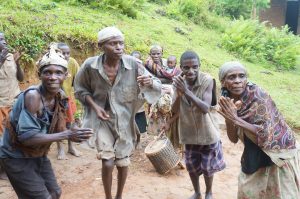 Yesterday morning I went on a trek to the edge of the Bwindi forest to meet the last of the Batwa tribe (known popularly but pejoratively, as the Pygmies.) My guide translated as one of the old men of the tribe narrated how they’d been evicted form the forest that had been their home for centuries and are now forced to eke out a miserable existence. They talked about the different herbs they use as medicine and did a little welcome dance that I was forced to join. (As you well know, I’m not big on dancing until after my 12th beer). They taught me how to use the bow and arrow in hunting, how to make fire with sticks, and also several words of their language. I felt really sad at their plight. They once numbered in the thousands. Today they’re reduced to just 500. Another group of people set for extinction as capitalism plunders the earth’s forests and ravages the land on an industrial scale. When will we ever learn to live in harmony with nature…!
Yesterday morning I went on a trek to the edge of the Bwindi forest to meet the last of the Batwa tribe (known popularly but pejoratively, as the Pygmies.) My guide translated as one of the old men of the tribe narrated how they’d been evicted form the forest that had been their home for centuries and are now forced to eke out a miserable existence. They talked about the different herbs they use as medicine and did a little welcome dance that I was forced to join. (As you well know, I’m not big on dancing until after my 12th beer). They taught me how to use the bow and arrow in hunting, how to make fire with sticks, and also several words of their language. I felt really sad at their plight. They once numbered in the thousands. Today they’re reduced to just 500. Another group of people set for extinction as capitalism plunders the earth’s forests and ravages the land on an industrial scale. When will we ever learn to live in harmony with nature…!
*** *** ***
Wow, today after trekking for five hours through thick jungle, soggy mud, giant cobwebs and getting leeches off my legs and insects off my face, I encountered a family of highland mountain gorillas. It was one of the most sublime experiences of my life.
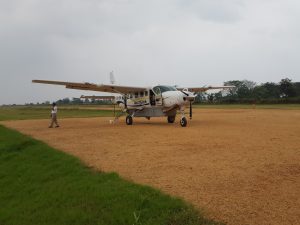 From Entebbe I took a light plane to the township of Kihihi, which has a small airstrip. From there it was a two-hour bumpy ride in a dilapidated Land Cruiser to the village of Buhoma. It’s not even a village really, just a few lodges, a community school, and a makeshift hospital. Anyway, apparently it’s one of the best places in Western Uganda to find mountain gorillas. It is home to half the world’s wild mountain gorillas. The area also has 358 species of bat, 360 different species of birds, 120 species of mammal, an astonishing ELEVEN species of primate (including the wonderful L’Hoest’s monkey), duikers, bushbuck, African golden cats, the rare giant forest hog, and the endangered African green broadbill.
From Entebbe I took a light plane to the township of Kihihi, which has a small airstrip. From there it was a two-hour bumpy ride in a dilapidated Land Cruiser to the village of Buhoma. It’s not even a village really, just a few lodges, a community school, and a makeshift hospital. Anyway, apparently it’s one of the best places in Western Uganda to find mountain gorillas. It is home to half the world’s wild mountain gorillas. The area also has 358 species of bat, 360 different species of birds, 120 species of mammal, an astonishing ELEVEN species of primate (including the wonderful L’Hoest’s monkey), duikers, bushbuck, African golden cats, the rare giant forest hog, and the endangered African green broadbill.
The big question everyone asks is, how can one get close to wild gorillas? The answer is there are two types of wild gorillas – those that are habituated to humans and those that aren’t. The ones that aren’t habituated will either attack humans or flee. But the ones that are habituated to humans will ignore them. At any rate, one pays $800 for a gorilla tracking permit. You get a guide, two armed escorts (who have actual AK47 rifles), and a couple of trackers who are already in the jungle monitoring the movements of the gorilla family. This area has three gorilla families: Rushegura, Mubare, and Habinyanza. After setting out with my raincoat and hiking boots and making sure my camera was fully charged we trekked for five hours until we encountered the Mubare family of gorillas.
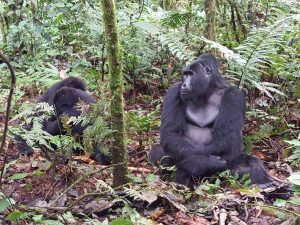 As we approached the family the scouting party suddenly went silent. We could hear rustling and leaves falling off the tree and branches being snapped. Suddenly, I heard this loud sound: PFFFRRRRRRRRRRRRRRRRRRRRRRRR! I turned to my guide in panic and said, “WTF was that!!!!” He grinned and said, “It iz not a halicopta landin’ – it iz a Gorillah passin’ weend!” I thought to myself, “Good grief! Who would have thought gorilla-farts would sound like American Military Choppers!”
As we approached the family the scouting party suddenly went silent. We could hear rustling and leaves falling off the tree and branches being snapped. Suddenly, I heard this loud sound: PFFFRRRRRRRRRRRRRRRRRRRRRRRR! I turned to my guide in panic and said, “WTF was that!!!!” He grinned and said, “It iz not a halicopta landin’ – it iz a Gorillah passin’ weend!” I thought to myself, “Good grief! Who would have thought gorilla-farts would sound like American Military Choppers!”
One of the trackers then whipped out this menacing-looking machete and started hacking away at the vegetation and cleared a short path. He then turned back to me, put his finger to his lips to indicate silence, and gesticulated to me to come over. I did. And there, in front of me, not more than five feet away was the alpha male, a MAJESTIC silverback. He regarded me impassively and chewed on some leaves. I was awestruck! His chest was massive, the muscles on his arms were rippling. And he had this massive scar above his left eye that my guide, David, said was from a previous fight to protect his harem of female gorillas from an outside male.
*** *** ***
I know it’s on record that I don’t care for human babies. But when I saw the two gorilla babies, I was totally like a suburban Californian mum: cooing, coddling, and cosseting. They were SO CUTE! SO adorable!!! With their teeny tiny hands, their curious eyes, and their uncoordinated little legs… oh, my word! My heart melted!
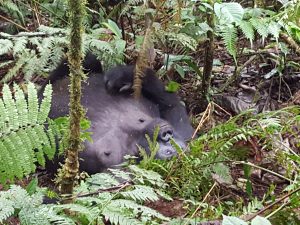 We stayed for an hour and observed them. From a naturalists point of view I noted that the female gorillas have large nipples/teats but they don’t have the kind of bulbous breasts that human females do. Ethologists have wondered about why human females developed bulbous breasts – especially because they’re not helpful and actually hinder the suckling human infant’s attempts while feeding. The answer might be that the large human breasts evolved as a sexual signal. (Only someone with a PhD would need to be told that – it’s quite obvious to any teenage boy or sophomore male, I’m sure! 😛 ) It’s the same with the gorilla penis. Of all the higher primates, gorillas are the largest in body size, but they have the smallest penis – about 2 inches. Why? Useful to first compare with other great apes. Human males have on average a 5-inch penis, but relatively average-sized testicles (in comparison to other apes). Chimps on the hand, have an average sized penis, but massive testicles. Why? What’s going on with these great apes: gorillas, chimps, humans…. Well, this is very interesting. The Ethologist, Desmond Morris, posits that human males don’t need such a big penis to impregnate the female. The gorilla’s 2-inch penis will more than suffice to do the job. The human male penis size is a result of sexual selection (just like the peacock’s flamboyant tail.) Over the millions of years of human evolution, larger male penis size tended to be favoured by females as a sign of virility. But why then do chimps have such large testicles compared to humans? Well, the answer has a lot to do with how monogamous or polygamous the ape is. A silverback gorillas is the undisputed leader of his pack. No other males are allowed to copulate with the female, so he doesn’t need massive reserves of semen in his testicles. However, chimps have no such single alpha male who can ensure submission from the other males in the pack. Chimp females mate with several males repeatedly one after the other. The only way for a male chimp to ensure his genes get passed on is to ensure he has enough semen to impregnate females even after several males have ejaculated inside her. (Bonobos are even more sexually active – the big difference between bonobos and chimps is the former are far more peaceful and when rival tribes meet they have sex in one massive orgy – as opposed to chimps who will fight rival tribes).
We stayed for an hour and observed them. From a naturalists point of view I noted that the female gorillas have large nipples/teats but they don’t have the kind of bulbous breasts that human females do. Ethologists have wondered about why human females developed bulbous breasts – especially because they’re not helpful and actually hinder the suckling human infant’s attempts while feeding. The answer might be that the large human breasts evolved as a sexual signal. (Only someone with a PhD would need to be told that – it’s quite obvious to any teenage boy or sophomore male, I’m sure! 😛 ) It’s the same with the gorilla penis. Of all the higher primates, gorillas are the largest in body size, but they have the smallest penis – about 2 inches. Why? Useful to first compare with other great apes. Human males have on average a 5-inch penis, but relatively average-sized testicles (in comparison to other apes). Chimps on the hand, have an average sized penis, but massive testicles. Why? What’s going on with these great apes: gorillas, chimps, humans…. Well, this is very interesting. The Ethologist, Desmond Morris, posits that human males don’t need such a big penis to impregnate the female. The gorilla’s 2-inch penis will more than suffice to do the job. The human male penis size is a result of sexual selection (just like the peacock’s flamboyant tail.) Over the millions of years of human evolution, larger male penis size tended to be favoured by females as a sign of virility. But why then do chimps have such large testicles compared to humans? Well, the answer has a lot to do with how monogamous or polygamous the ape is. A silverback gorillas is the undisputed leader of his pack. No other males are allowed to copulate with the female, so he doesn’t need massive reserves of semen in his testicles. However, chimps have no such single alpha male who can ensure submission from the other males in the pack. Chimp females mate with several males repeatedly one after the other. The only way for a male chimp to ensure his genes get passed on is to ensure he has enough semen to impregnate females even after several males have ejaculated inside her. (Bonobos are even more sexually active – the big difference between bonobos and chimps is the former are far more peaceful and when rival tribes meet they have sex in one massive orgy – as opposed to chimps who will fight rival tribes).
So what does that say about human sexual behaviour? Well, going by testicles size and body dimorphism, it would seem that humans evolved to be more monogamous than polygamous. (This explains why even though a billion Muslims have the right to take several wives – they don’t. The vast vast majority of humans and human societies favour monogamy.
*** *** ***
Currently, it’s lightening and thundering and POURING rain outside my lodge. I haven’t seen rain this heavy anywhere except during the height of the monsoons in Southern India. Tomorrow I have a 12-hour drive to Kibale, which has a large concentration of chimpanzees.
*** *** ***
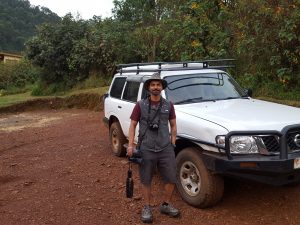 Ok, I’m on the last leg of my sojourn in Western Uganda. Let me tell you about my encounter with our closest relatives in the Hominidae family, the chimpanzee (well, second closest, if we’re being pedantic – bonobos are our closest relatives – they’re a different species to chimps – though both share the same genus: Pan). I’d seen a few chimps before though – in Tanzania several years ago.
Ok, I’m on the last leg of my sojourn in Western Uganda. Let me tell you about my encounter with our closest relatives in the Hominidae family, the chimpanzee (well, second closest, if we’re being pedantic – bonobos are our closest relatives – they’re a different species to chimps – though both share the same genus: Pan). I’d seen a few chimps before though – in Tanzania several years ago.
But this time it was a very different experience tracking the chimps. They are much more mobile and raucous than the gorillas. Also, the jungle is very different to the highlands. It was hot and humid, and boy there were ants everywhere! (An old American lady got ants inside her top and suddenly I heard her screaming. She had literally undone her buttons and was frantically brushing away the ants. I tried to avert my gaze as quickly as I could, but it was too late: the sight of her wrinkled saggy breasts is now seared in my brain. I thought to myself, oh no! I’m going to have nightmares about this! Anyway, she was screaming hysterically, shaking the ants off her hair and her arms… totally frantic. My guide, an indomitable lady named Sheila Mulemba, looked with equanimity at the frenetic American lady (who was still thrashing her legs and flailing her arms) and whispered to me, “This is what we call an African dance.”
Anyway, all ended well. And we trekked deeper into the forest. It was my singular misfortune to have three Americans in my group. I hate to disparage an entire people, but honestly, many Americans just can’t shut up. They have this annoying habit of uttering every inane thought that comes to their head. It’s like they can’t keep their thoughts to themselves. They would utter every random thought that entered their head. “Oh man, look at all that moss!” “I wonder if the chimps know we’re here.” “Chimps, eh, chimps… we’re going to see chimps…” Just verbal diarrhoea. It reached a point when I wanted to turn to them and say, “Please shut up and enjoy the silence.” I didn’t.
Suddenly, a troupe of Chimps was up ahead of us. They saw us and started howling and chattering and yelping and breaking branches. Then they started to speed away from us. We had to race onward to keep pace with them. Through the underbrush, tripping over vines, branches slapping against our arms, cobwebs on our face… but on we went deeper and deeper. Soon, the chimps settled down. Some lounged about on the ground picking lice off each other’s fur. Others clambered up the trees. Most just ate figs and stared philosophically into the distance.
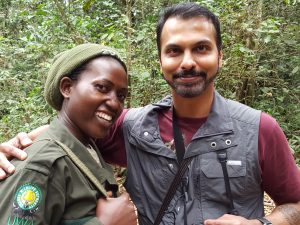 Sheila was telling me about the various plants in the forest. She pointed to one and said it was wild lemon. Some men believe that if you ground the roots and mix it with your tea it works like a natural Viagra. I asked her if it really worked. She gave me a quizzical look and said, “I don’t know. I am not a man.” Suddenly it began to drizzle. She said, “Warm showers.” I decided to take a picture of the wild lemons. She said again, “Warm showers.” I thought, “Shucks, I didn’t bring my raincoat.” She said a third time, “Warm showers.” This time I looked up from my camera and stared at her. She had this impish glint in her eye and a puckish smile. I looked up in horror and ran hell for leather from there. All those drops I was being covered in that I thought was rain was actually a chimp urinating on me from the treetops! Fahhck! 😀 (Anyway, no harm done. As you probably know, urine is sterile: there’s no germs or bacteria in it. Humans can safely drink their own urine. It won’t do any harm. But it won’t give any benefits either. A former Indian Prime Minister, Moraji Desai, used to drink his own pee every day and lived to be 99). Hindu fanatics bathe in and drink cow urine even today).
Sheila was telling me about the various plants in the forest. She pointed to one and said it was wild lemon. Some men believe that if you ground the roots and mix it with your tea it works like a natural Viagra. I asked her if it really worked. She gave me a quizzical look and said, “I don’t know. I am not a man.” Suddenly it began to drizzle. She said, “Warm showers.” I decided to take a picture of the wild lemons. She said again, “Warm showers.” I thought, “Shucks, I didn’t bring my raincoat.” She said a third time, “Warm showers.” This time I looked up from my camera and stared at her. She had this impish glint in her eye and a puckish smile. I looked up in horror and ran hell for leather from there. All those drops I was being covered in that I thought was rain was actually a chimp urinating on me from the treetops! Fahhck! 😀 (Anyway, no harm done. As you probably know, urine is sterile: there’s no germs or bacteria in it. Humans can safely drink their own urine. It won’t do any harm. But it won’t give any benefits either. A former Indian Prime Minister, Moraji Desai, used to drink his own pee every day and lived to be 99). Hindu fanatics bathe in and drink cow urine even today).
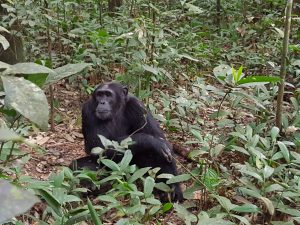 Anyway, the chimps were a big troupe – around 200 in the community – but we saw only around 30-40 of them. After years of watching them on nature documentaries and National Geographic, it was wonderful to see them in their habitat. I was glad I’d read all those books by Jane Goodall and her epic experiences with chimps in the wild since she first went there in the 1950s to work with the legendary anthropologist Louis Leakey. (She was part of the “Trimates” or “Leakey’s Angels” – a name given to three women — Jane Goodall, Dian Fossey, and Birutė Galdikas — chosen by Leakey to study hominids in their natural environments. They studied chimpanzees, gorillas and orangutans respectively. Sadly, Dian was hacked to death by gorilla hunters. They made a film of her life called “Gorillas in the Mist” starring Sigourney Weaver – but this was nearly 25 years ago…)
Anyway, the chimps were a big troupe – around 200 in the community – but we saw only around 30-40 of them. After years of watching them on nature documentaries and National Geographic, it was wonderful to see them in their habitat. I was glad I’d read all those books by Jane Goodall and her epic experiences with chimps in the wild since she first went there in the 1950s to work with the legendary anthropologist Louis Leakey. (She was part of the “Trimates” or “Leakey’s Angels” – a name given to three women — Jane Goodall, Dian Fossey, and Birutė Galdikas — chosen by Leakey to study hominids in their natural environments. They studied chimpanzees, gorillas and orangutans respectively. Sadly, Dian was hacked to death by gorilla hunters. They made a film of her life called “Gorillas in the Mist” starring Sigourney Weaver – but this was nearly 25 years ago…)
*** *** ***
So we stayed for an hour, took pics, and then came back to camp. I drove to my lodge – a place called “Chimps Nest.” It’s right in the forest, very Spartan, outdoor toilet facilities, diesel generator for electricity, gasoline lamps, and mosquito-netted beds… just like in the movies. I was the only person staying in that lodge. So in the evening I settled in the lounge area with a bottle of beer and my Somerset Maugham novel. And that’s when I met one of the most interesting people in my travels…
*** *** ***
To be continued…